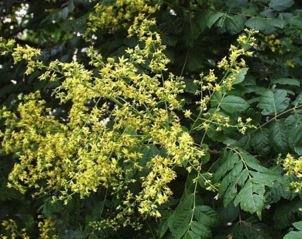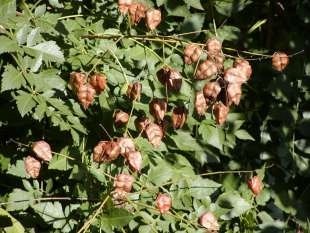Showers of Golden Rain Tree
The scallions didn’t have a chance.
My Taiwanese friend liked to grow scallions in a postage stamp garden in her back yard. They added fresh flavor to her down-home Chinese cooking. But her neighbor had a Golden Rain Tree that loomed over the scallion patch like an ominous shadow. In the fall it was constantly showering her garden with seed capsules, producing hundreds of sprout seasonally. The tree eventually won. Unfortunately this was a quarter of a century before I knew those Golden Rain Tree shoots were edible. You must, however, have the right species.
This particular Golden Rain Tree was a Koelreuteria paniculata (kole-roo-TEER-ee-uh pan-ick-yoo-LAY-tuh) a native of China and Japan. It was named for Joseph Gottlieb Kolreuter, 1733-1806, who carried out experiments in hybridization and published research about tobacco. He was noted for two things; his ingenious experiments and his complaint that professors of botany didn’t make much money. My German isn’t that good but I think Koelreuter can mean “cabbage patch” or “cabbage thief.”
Besides eating tender young shoots and leaves (boiled) the yellow flowers produce a yellow dye and an eye wash. The mature leaves produce a black dye. As for eating the seeds… all reports say they are roasted but acidic, which makes sense as they have the same irritating oil found in unrefined canola oil (which if I remember correctly is erucic acid.) Their the seeds also might be insecticidal. By most accounts the roasted seeds are a famine food. I have not tried them. They’re on my list of things to do when I have better health insurance. The leaves and shoots have some antioxidant and anti-tumor “activity” but also have some traces of cyanide, hence the cooking. These are not for raw salads.
The Golden Rain Tree was introduced to the west from China by Jesuit missionary, Pierre d’Incarville in 1747. The trees were under cultivation in Jardin du Roi by 1763. The tree reached America by 1809 when Thomas Jefferson germinated seeds sent to him by a French friend. While it has since become a popular landscape tree worldwide it is also an invasive species in many places including Florida.
Green Deane’s “Itemized” Plant Profile
IDENTIFICATION: Trees or shrubs, deciduous, bark grayish brown to black, stout, fissured, lenticels gray to dark brown, small; branches tuberculate, appressed pubescent or glabrous with axes and petioles. Leaves fascicled on young branches, spreading, pinnate, imperfectly bipinnate, or sometimes bipinnate, sessile or very shortly petiolate, opposite or alternate, ovate or broadly ovate to ovate-lanceolate, sometimes hairy or densely pale yellow pubescent. Flowers pale yellow, slightly fragrant, 4 petals
TIME OF YEAR: Locally it is in its ornamental glory in October.
ENVIRONMENT: Full sun, rich soil, will tolerate some variation.
METHOD OF PREPARATION: Boiled young shoots and leaves, roasted seeds… perhaps.
HERB BLURB
SUN Bao-teng et al (College of Life Science,Nanchang, University,Nanchang,Jiangxi 330031)
[Objective] The study aimed to analyze the oil content in seed kernel and the components of fatty acid in the seed oil of Koelreuteria bipinnata Var.integrifolia T.Chen.[Method] The seed oil of K. bipinnata was extracted with soxhlet extraction and the oil content in seeds was calculated. The component of fatty acid in seed oil was detected with gas chromatograph-mass spectrometer after the fatty acid being methyl esterified.[Result] The oil content in seed kernel of K. bipinnata reached 54.04%. There were 5 saturated fatty acids and 3 unsaturated fatty acids in seed oil,among which,the content of unsaturated fatty acid reached 75.26%,and the unsaturated fatty acid mainly contained oleic acid(31.07%), eicosenoic acid(35.07%) and erucic acid(9.12%). The nutrition value of seed oil of K. bipinnata was higher,but in which there were no polyunsaturated fatty acid with more higher nutrition value and there were erucic acid and arachidic acid that indigestible in the oil.[Conclusion] The seed oil of K. bipinnata had higher nutrition value, but whether it could be used as edible oil needs to make the toxicological study. (GREEN DEANE NOTE: Erucic acid is limited to 2% and 5% in Canada and Europe respectively in Canola Oil for food.)




